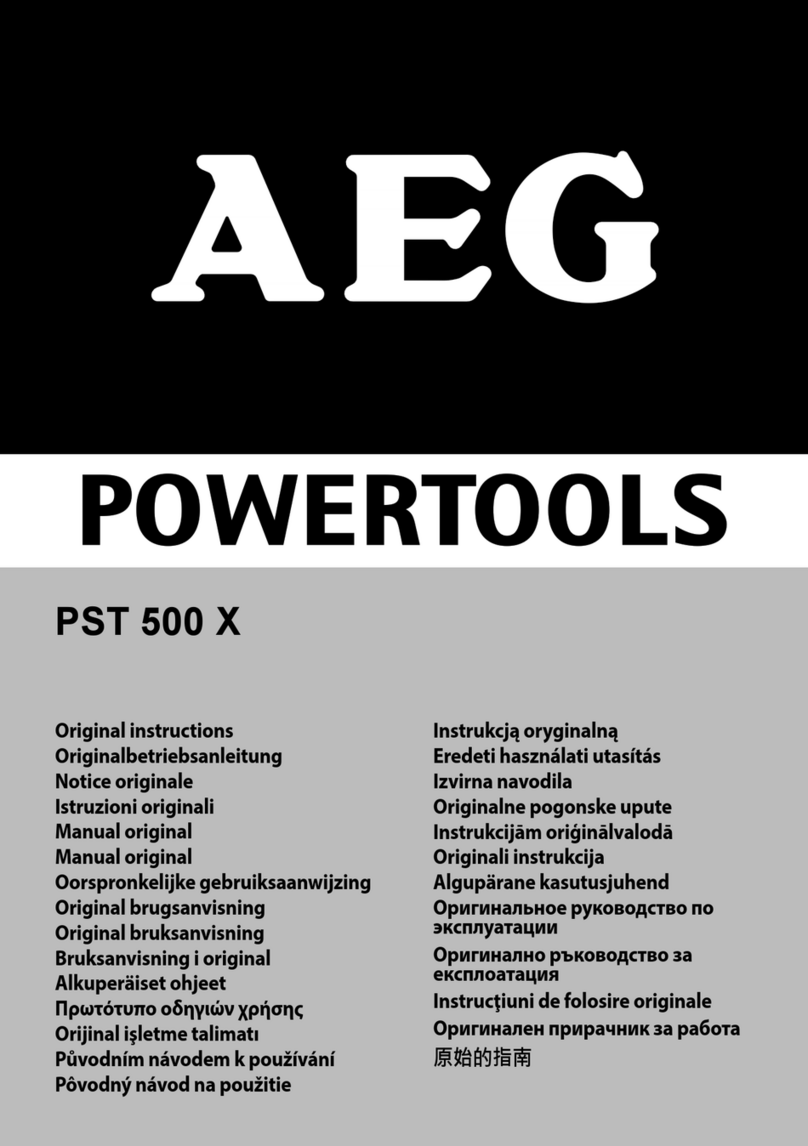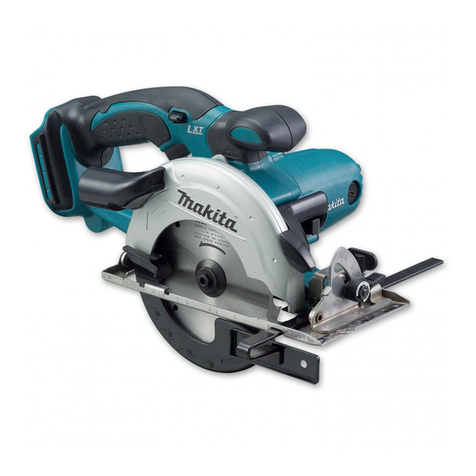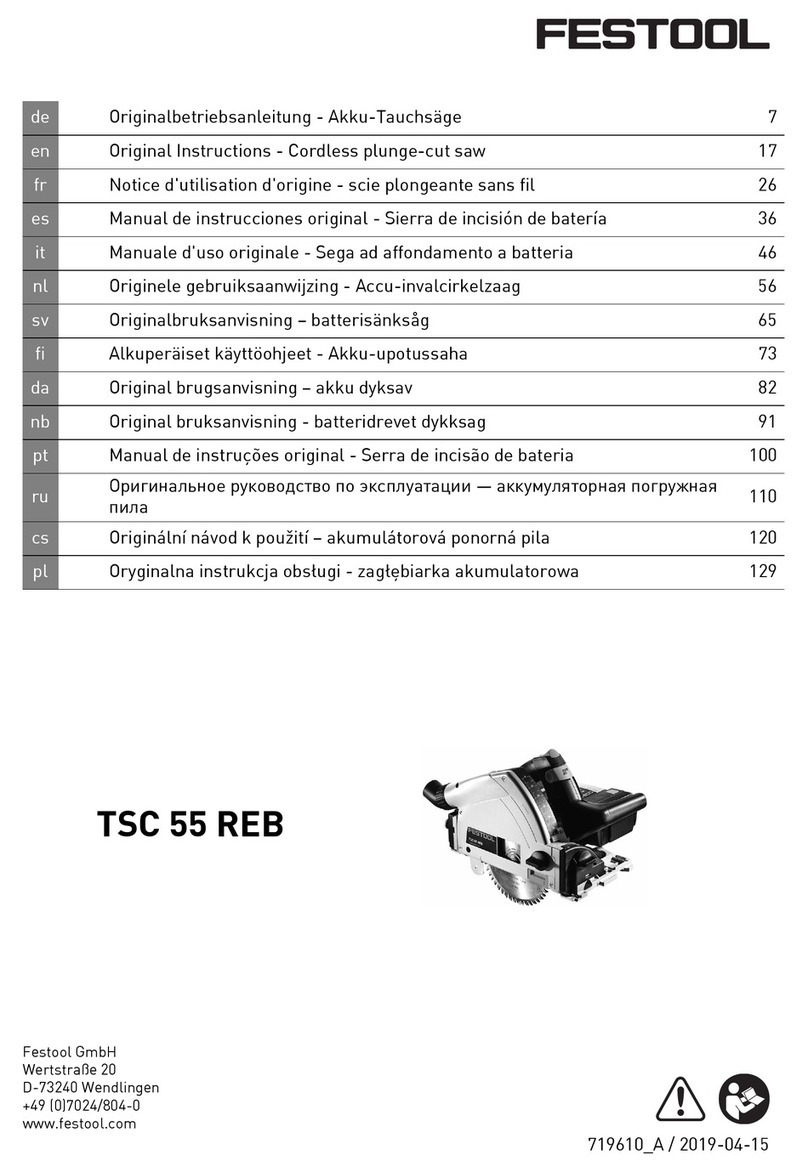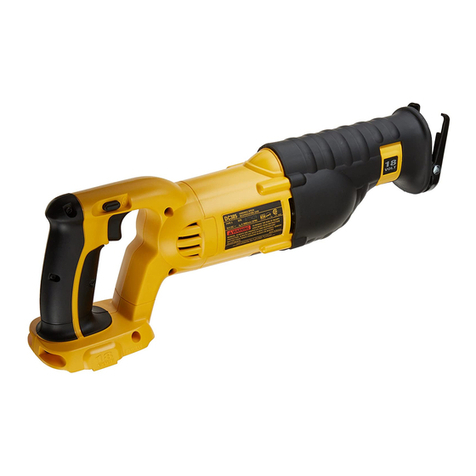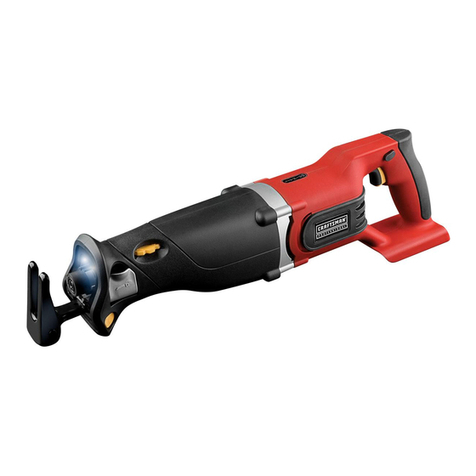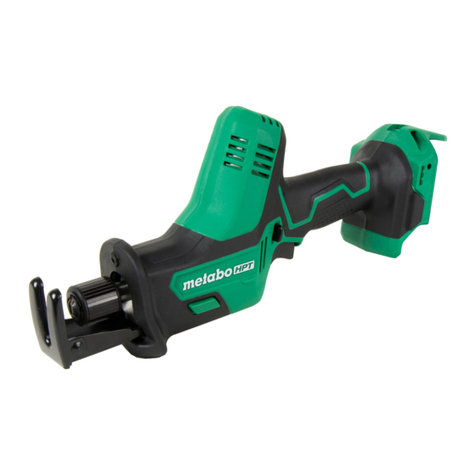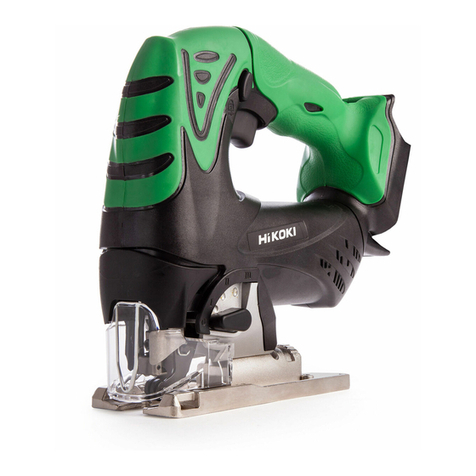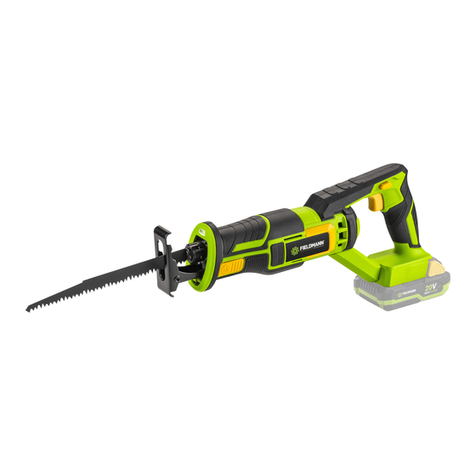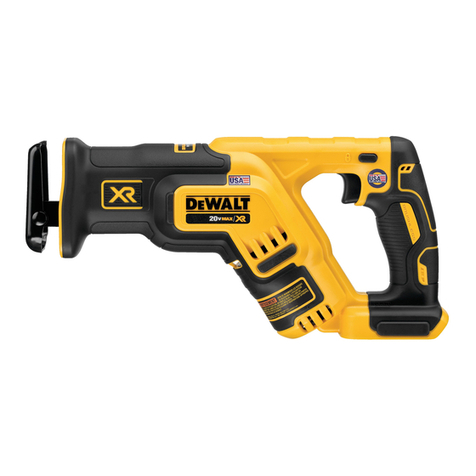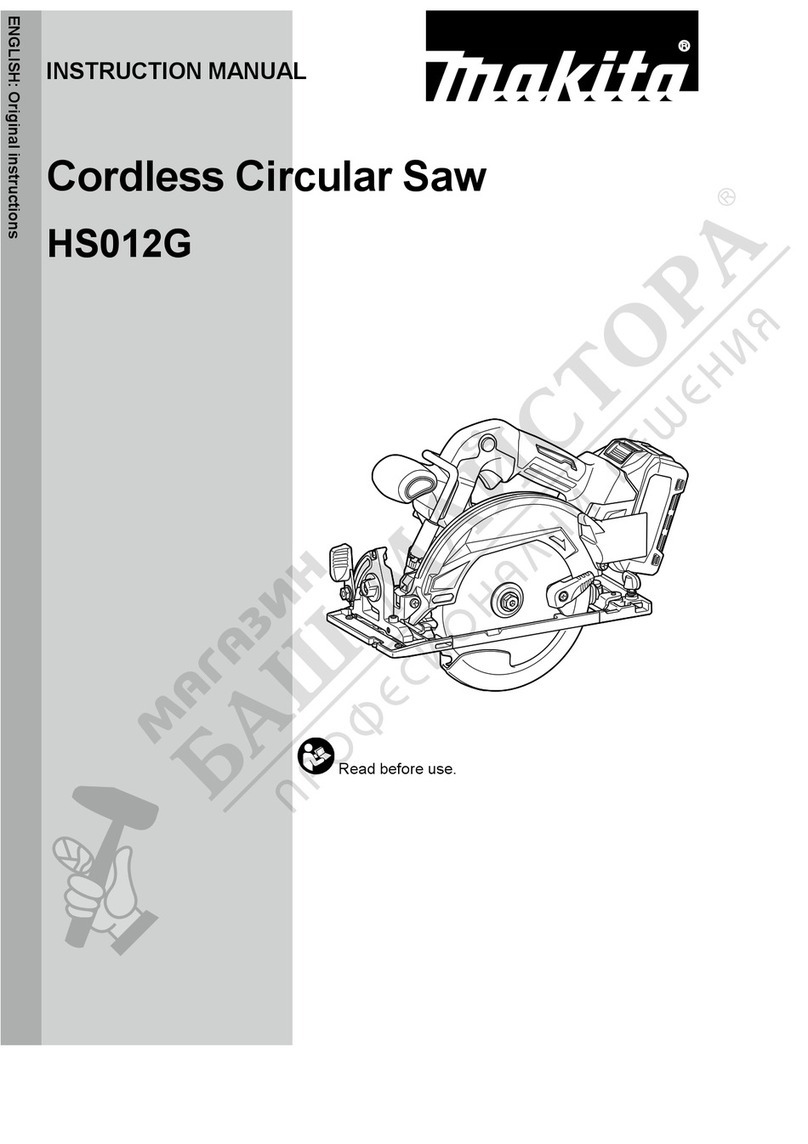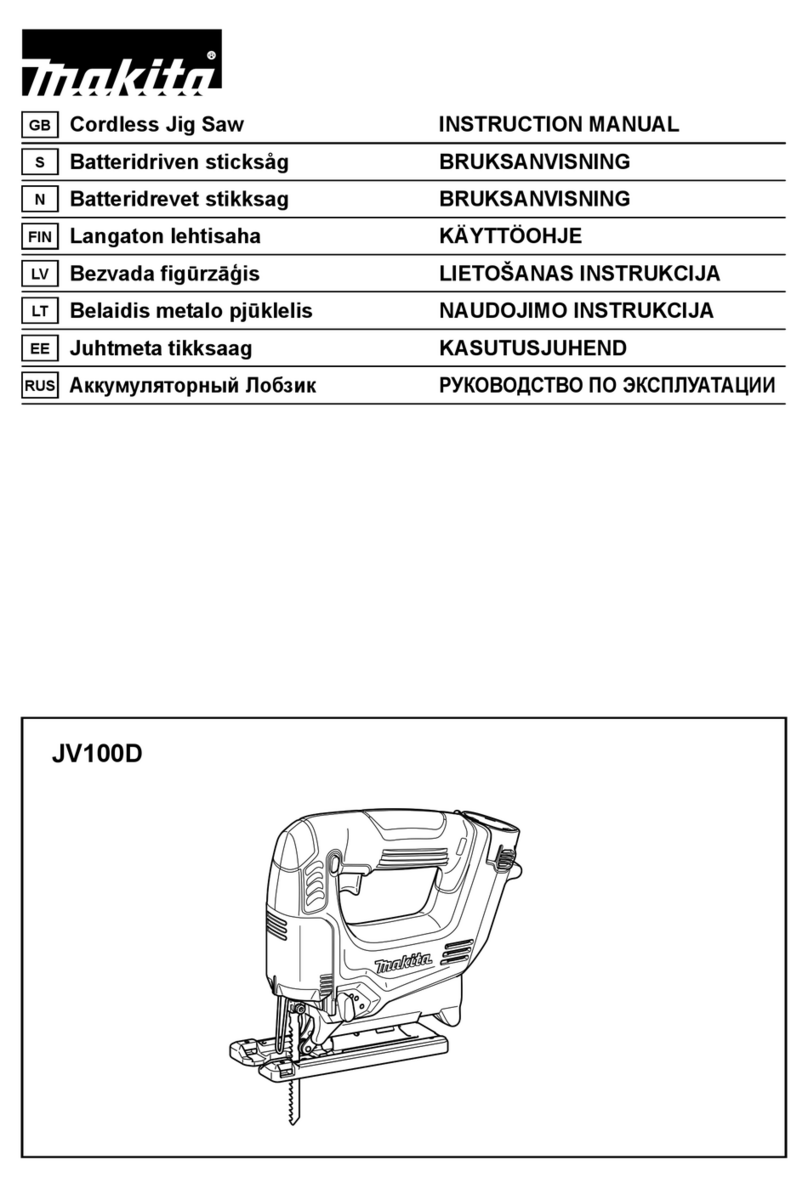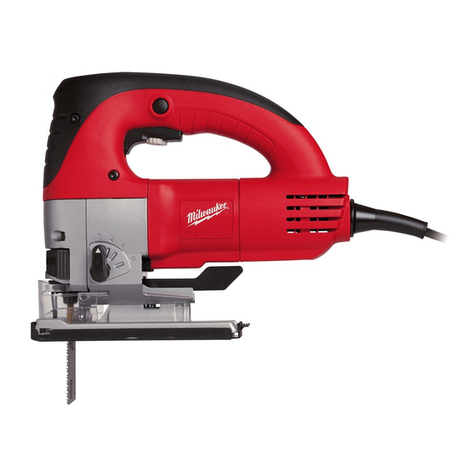Mac Afric SSAWRP-002 User manual


GENERAL POWER TOOL SAFETY WARNINGS
(For All Power Tools)
WARNING! Read and understand all instructions.
Failure to follow all
instructions listed below may result in electric shock, fire and/or serious personal
injury.
Save all warnings and instructions for future reference.
The term “power tool” in the warnings refers to your mains-operated (corded) power tool or
battery-operated (cordless) power tool.
Work Area Safety
1. Keep work area clean and well lit.
Cluttered or dark areas invite accidents.
2. Do not operate power tools in explosive atmospheres, such as in the presence of flammable
liquids, gases, or dust.
Power tools create sparks which may ignite the dust or fumes.
3. Keep children and bystanders away while operating a power tool.
Distractions can cause you
to lose control.
Electrical Safety
4. Power tool plugs must match the outlet. Never modify the plug in anyway. Do not use any
adapter plugs with earthed (grounded) power tools.
Unmodified plugs and matching outlets
will reduce risk of electric shock.
5. Avoid body contact with earthed or grounded surfaces, such as pipes, radiators, ranges and
refrigerators.
There is an increased risk o electric shock if your body is earthed or grounded.
6. Do not expose power tools to rain or wet conditions.
Water entering a power tool will
increase the risk of electric shock.
7. Do not abuse the cord. Never use the cord for carrying, pulling or unplugging the power tool.
Keep cord away from heat, oil, sharp edges or moving parts.
Damaged or entangled cords
increase the risk of electric shock.
8. When operating a power tool outdoors, use an extension cord suitable for outdoor use.
Use of
a cord suitable for outdoor use reduces the risk of electric shock.
9. If operating a power in a damp location is unavoidable, use a residual current device (RCD)
protected supply.
Use of an RCD reduces the risk of electric shock.
NOTE: The term “residual current device (RCD)” may be replaced by the term “ground fault
circuit interrupter (GFCI)” or “earth leakage circuit breaker (ELCB)”.
Personal Safety
10. Stay alert, watch what you are doing and use common sense when operating a power tool.
Do not use a power tool while you are tired or under the influence of drugs, alcohol, or
medication.
A moment of inattention while operating power tools may result in serious
personal injury.
11. Use personal protective equipment. Always wear eye protection.
Protective equipment such
as dust mask, non-skid safety shoes, hard hat, or hearing protection used for appropriate
conditions will reduce personal injuries.
12. Prevent unintentional starting. Ensure the switch is in the off-position before connecting to
power source and /or battery pack, picking up or carrying the tool.
Carrying power tools with
your finger on the switch or energising power tools that have the switch on invites accidents.
13. Remove any adjusting key or wrench before turning the tool on.
A wrench or a key left
attached to a rotating part of the power tool may result in personal injury.
14. Do not overreach. Keep proper footing and balance at all times.
This enables better control of
the power tool in unexpected situations.
15. Dress properly. Do not wear loose clothing or jewellery. Keep your hair, clothing, and gloves
away from moving parts.
Loose clothes, jewellery or long hair can be caught in moving parts.
16. If devices are provided for the connection of dust extraction and collection facilities, ensure
these are connected and properly used.
Use of dust collection can reduce dust-related
hazards.
Power Tool Use and Care
17. Do not force the power tool. Use the correct power tool for your application.
The correct
power tool will do the job better and safer at the rate for which it was designed.
18. Do not use tool if switch does not turn it on or off.
Any power tool that cannot be controlled
with the switch is dangerous and must be repaired.
19. Disconnect the plug from the power source and/or the battery pack from the power tool

before making any adjustments, changing accessories, or storing power tools.
Such
preventive safety measures reduce the risk of starting the power tool accidentally.
20. Store idle power tools out of the reach of children and do not allow persons unfamiliar with
the power tool or these instructions to operate the power tool.
Power tools are dangerous in
the hands of untrained users.
21. Maintain power tools. Check for misalignment or binding of moving parts, breakage of parts
and any other condition that may affect the power tool’s operation. If damaged, have the
power tool repaired before use.
Many accidents are caused by poorly maintained power
tools.
22. Keep cutting tools sharp and clean.
Properly maintained cutting tools with sharp cutting
edges are less likely to bind and are easier to control.
23. Use the power tool, accessories and tool bits etc. in accordance with these instructions,
taking into account the working conditions and the work to be performed.
Use of the power
tool for operations different from those intended could result in a hazardous situation.
Battery Tool Use and Care
24. Recharge only with the charger specified by the manufacturer.
A charger that is suitable for
one type of battery pack may create a risk of fire when used with another battery pack.
25. Use power tools only with specifically designated battery packs.
Use of any other battery
packs may create a risk of injury and fire.
26. When battery is not in use, keep it away from other metal objects like: paper clips, coins,
keys, nails, screws, or other small metal objects that can make a connection from one
terminal to another.
Shorting the battery terminals together may cause sparks, burns, or a
fire.
27. Under abusive conditions, liquid may be ejected from the battery; avoid contact. If contact
accidentally occurs, flush with water. If liquid contacts eyes, additionally seek medical help.
Liquid ejected from the battery may cause irritation or burns.
Service
28. Have your power tool serviced by a qualified repair person using only identical replacement
parts.
This will ensure that the safety of the power tool is maintained.
Intended Use
The machine is intended for sawing wooden materials, plastic, metals and general building
materials. It can be used for both linear and curve sawing. Refers to the following table to choose
saw blade:
Material
Figure
Application
BIM
Thin Metal Plate
< 20mm
Pipe and Profile
< 90mm
(Linear Sawing
)
High Carbon Steel
Board< 90mm
Pipe and Profile
< 90mm
(Linear Sawing
)
SPECIFICATIONS
Voltage(DC)
18V
Stroke Length
28 mm
Battery
Type
Li-Ion
Capacity
4.0Ah
5.0 Ah
No-load Speed
0-3300 r/min
Max. Cutting Depth
Metal
20 mm
Wood
250 mm
Diameter of Pipe
Ø130 mm
※Due to the continuing program of research and development, the specifications herein are
subject to change without prior notice.

ADDITIONAL SAFETY RULES
1. Hold tool by insulated gripping surfaces when performing an operation on wall and
floor where the cutting tool may contact hidden wiring. Contact with a “live” wire will
also make exposed metal parts of the tool “live” and shock the operator.
2. Use appropriate detectors to determine if utility lines, such as electric lines, gas lines
and water lines are hidden in the work area before screwing or drilling on the wall,
floor or ceiling. Once
t
hose utility lines are drilled, it will cause fire and electric shock
accidents, explosion or other damages to properties.
3. Keep hands away from the sawing range. Do not reach under the workpiece. Contact
with the saw blade can lead to injuries.
4. Apply the machine to the workpiece only when switched on. Otherwise there is danger
of kickback when the cutting tool jams in the workpiece.
5. When sawing, the base plate must always faces against the workpiece. The saw blade
can become wedged and lead to loss of control over the machine
6. Clamp material well. Do not support the workpiece with your hand or foot. Do not touch
objects or the floor with the saw running.
7. When the cut is completed, switch off the machine and then pull the saw blade out of
the cut only after it has come to a standstill. In this manner you can avoid kickback and
can place down the machine securely.
8. Use only undamaged saw blades that are in perfect condition. Bent or dull saw blades
can break, negatively influence the cut, or lead to kickback.
9. Do not brake the saw blade to a stop by applying side pressure after switching off. The
saw blade can be damaged, break or cause kickback
10. When working with the machine, always hold it firmly with both hands and provide for a
secure stance. The power tool is guided more secure with both hands.
11. Secure the workpiece. A workpiece clamped with clamping devices or in a vice is held
more secure than by hand.
12. Always wait until the machine has come to a complete stop before placing it down. The
tool insert can jam and lead to loss of control over the power tool.
13. Recycle and use the damaged tools, accessories and abandoned packages in an
environmentally friendly way in accordance with the local laws.
SAVE THESE INSTRUCTIONS.
WARNING! MISUSE or failure to follow the safety rules stated in this instruction
manual may cause serious personal injury.
IMPORTANT INSTRUCTIONS FOR BATTERY & CHARGER
1. Always set the reversing switch lever in the central position (lock the switch) and
remove the battery cartridge before tool change, inspection, maintenance,
transportation, storage or something like that.
2. Always check and confirm the battery cartridge is installed properly before use.
3. It’s normal that the battery will become a little bit hotter while charging.
4. Do not charge for the damaged battery.
5. After charging, unplug the charger from power source and then remove the battery
cartridge from the charger. Do not leave the battery cartridge in the charger after the
charging cycle is completed.
6. Do not put the charged battery cartridge in the charger when the tool is not used.
7. Do not disassemble charger or battery; take it to a qualified serviceman when service
or repair is required; incorrect reassembly may result in a risk of electric shock or fire.
8. Do not short the battery cartridge.
9. Do not burn the battery. It will explode in a fire.
10. Be careful not to drop, shake or strike the battery.
11. Do not use battery as hammer. Knocking it may cause accidental short circuit, fire or
explosion.
12. Keep battery far from fire and high temperature. Never place battery on radiator or
expose it under continuous sun irradiation. There is danger of explosion.

13. Keep work area well-ventilated. Improper use of battery or damaged battery may send
out toxic gases, which can cause personal injury.
14. Overheating or overusing of the battery may cause liquid escape and come into contact
with the adjacent components. Clean such parts or replace them, if required. If electrolyte
contacts with your skin, wash the contacted area with soap firstly and then wash with
lemon juice and vinegar. If electrolyte gets into your eyes, rinse them out with clear water
and seek medical attention right away.
15. If operating time with a battery has become excessively shorter after charging, stop
operating immediately and replace with a new one or go to maintenance for inspection.
Continuous using of a worn out battery may result in a risk of overheating, possible burns
and even an explosion.
16. Do not expose battery cartridge to rain, snow or wet conditions.
17. Store battery cartridge properly:
a) Store the battery after it is fully charged
b) Store the battery only within a temperature range between 0℃and 45℃. Too hot or
too cold may damage the battery.
c) Avoid storing battery nearside paper clips, coins, keys, nails, screws, or other small
metal objects that can make a connection from one Avoid storing battery nearside
paper clips, coins, keys, nails, screws, or other small metal objects that can make a
connection from one terminal to another. Shorting the battery terminals together
may cause sparks, burns, or a fire.
18. Do not dispose of damaged or worn out battery into household waste, fire or water.
19. Damaged or worn out battery/batteries should be collected, recycled or disposed of in an
environmental-friendly manner.
20. Do not charge for the battery when room temperature is lower than 10℃or higher than
50℃. The battery cannot be charged when room temperature is lower than 0℃.
SAVE THESE INSTRUCTIONS.
GENERAL DESCRIPTIONS
INSTRUCTIONS FOR OPERATION
Battery Charging
Check the user manual of battery charger for detailed information.
CAUTION:
Only use battery chargers are matched to the lithium ion battery of your power tool. DO not
use other type of battery charger.
A battery removed from a long-time operated tool or left in the over-heated atmosphere for
a long time should be cooled down before being charged. Otherwise it will shorten the
1. Saw Blade
2. Base Plate
3. Locking Sleeve for Saw Blade
4. Stroke Rod
5. Battery Indicator
6. Button of Battery Indicator
7. Unlocking Button of Battery Cartridge
8. Battery Cartridge
9. Switch
10. Safety Switch

servicing life of the battery or cause the battery unable to be charged.
To achieve best performance, a new battery cartridge or a battery cartridge not used for a
long time should be charged and discharged for 3 to 4 cycles.
If operating time with a battery has become excessively shorter after every charging,
replace it with a new one.
Installing or Removing Battery Cartridge
CAUTION:
Use only the battery chargers listed on the accessories page. DO not use other type of battery
charger, or there will be the danger of explode, which may cause personal injuries and property
loss.
Installing the Battery Cartridge
To install the battery firmly, insert it properly all
the way until it locks in place with a little click. If
not, it may accidentally fall out of the tool, causing
injury to you or someone around you. Avoid
overexerting or hammering the battery into the
motor housing with the help of other objects.
(Fig.1)
Removing the Battery Cartridge
To remove the battery, press the unlocking
buttons on both sides and pull out the battery
downwards. Do not exert any force. (Fig.2)
Battery Indicator
CAUTION:
The four charging lights may flash in red color if
the tool is overheated or overloaded. As
temperature recovers or over-load protection is
removed, press the switch and the tool can be
started normally.
Current power of the battery will be indicated by
the battery indicator when pressing the battery
button or switching on the tool. (Fig. 3)
Four red LED lights are set to indicate the battery power which can be referred to the following table.
Status of
Red LED Lights
Approx. Battery Power Left
4
lights lit
≥
3/4
3
lights lit
≥
1/2
2
lights lit
≥
1/4
1
light lit
<
1/4
1 light flash
Low l
evel
Battery Charging
1. Battery Charger
CAUTION:
Make sure that the AC voltage of the power source meets the requirement specified on the
nameplate of the charger.
1. Plug the battery charger into the proper AC power source. The charging indicator light will
flicker in green color and the charger operates in standby mode.
2. Insert the battery pack fully into the battery charger and the charger starts charging.
※Due to the continuing program of research and development, the specifications herein are
subject to change without prior notice.

2. Charging Operation
The battery charger can detect some sort of
failure caused by the battery and indicates by the
statuses of the red and green indicator lights.
When a failure occurs, remove the battery and
then insert it into the charger again. If the failure
continues, change with a new battery. If the new
battery can be charged, then the old battery
maybe damaged. If the charging indicator lights
indicate same failure as before while changing
with a new battery, then the charger maybe damaged, take the charger to be repaired by
qualified serviceman. (Fig. 4)
The following chart lists the relations between the statuses of charging and charging indicator
lights.
Descriptions of
Charging Status Icons
Icons of Charging
Indicator Lights Descriptions of
Charging Indicator
Lights
Green
Light
Red
Light
Plug the charger into
a proper outlet Green light flickers, red
light extinguished
During charging
Green light extinguished,
red light keeps
flickering steadily
Charge complete
Green light keeps up
steadily, red light
extinguished
Abnormity occurs on
the battery
Green and red light
flicker alternately
The temperature of
the battery is under
0℃or higher than
50℃
Green light extinguished,
red light flickers
Using battery cartridge properly
Do not expose battery cartridge to rain, snow or wet conditions. Store the battery only within a
temperature range between 0℃and 45℃. Do not put the battery cartridge in the car in summer.
If operating time with a battery has become excessively shorter after charging, stop operating
immediately and replace with a new one or go to maintenance for inspection.
■Disposal of Battery Cartridge
Lithium ion battery is contained in the battery pack. For environmental protection, recycle or
dispose of the worn out battery properly. Please consult with your local relevant departments
about how to recycle and/or dispose of the worn out battery.
To recycle or dispose of the worn out battery:
a) Remove the battery from the tool when it is worn out.
b) Wrap the terminals with a strong tape to avoid short-circuit and electric leakage.
Never attempt to disassemble or disembowel the battery!
Inserting/Replacing Saw Blade
CAUTION:
Always remove battery cartridge before mounting or replacing the saw blade.
When mounting the saw blade, wear protective gloves. There will be the danger of injury
when touching the saw blade.
When changing the saw blade, take care that the saw blade holder is free of material
residue, e. g. wood or metal shavings.
Model FFCL18-01
FFCL18-03
SCHARG-001
(FFCL18-04)
Input Voltage (AC) 220-240V 110-240V
Charging Current 3.0A
Input Power Frequency 50-60Hz
Applicable Battery Cartridge Voltage
(DC) 14.4-18V
Full Charging Time
4.0 Ah ≈90min
5.0 Ah ≈100min
Insulation Grade Double Insulation

Selecting Saw Blade
Use only saw blades suitable for the material being worked. Select a suitable saw blade
according to the workpiece in reference to the table as mentioned in intended use. The saw
blade should not be longer than required for the intended cut. Use a thin saw blade for narrow
curve cuts.
Inserting Saw Blade
CAUTION:
Check the tight seating of the saw blade. A loose saw
blade can fall out and lead to injuries.
Turn the locking sleeve approx. 90° in the direction of
the arrow and hold it. Insert the saw blade into the saw
blade holder.
For some special work, the saw blade can also be
turned through 180° (with the teeth pointed upwards)
and re-inserted again. (Fig.5)
Removing Saw Blade
Turn the locking sleeve approx. 90° in the direction of
the arrow and hold it. Remove the saw blade. (Fig.6)
Adjusting Base Plate
Pull out the base plate and start the tool. The available
cutting position is mainly the front end of saw blade.
The abrasion of saw blade’s front end affect the tool’s
cutting efficiency. Adjusting the extension length of
base plate can change the available cutting position
and increase the cutting efficiency.
To adjust the base plate, press the adjustment button,
push the base plate according to the direction of the
arrow until it locks in place with a little click. (Fig.7)
Operation
CAUTION:
Lock the safety switch if the tool is not in use.
To switch on the tool, unlock the safety switch
first and then press the speed-control switch.
Speed-control switch can adjust stroke rate
variously. The required stroke rate is dependent
on the material and the working conditions and
can be determined by a practical trial. Reducing
the stroke rate is recommended when the saw
blade engages in the material as well as when sawing plastic and aluminum.
To switch off the tool, simply release the speed-control switch. (Fig.8)
Saw Dust
Pigment with lead or dust generated from some wood, mineral or metal can damage health. The
operator or people near the working area may suffer from allergies or respiratory tract infection if
they breathe in those dusts. Such dust generated from oak may be carcinogenic, especially when
mixed with additive. Only people with special training can process materials with asbestos.
Keep working area well ventilated.
Wear respirator of grade P2 when operating.
Avoid working area from accumulating too much dust, or there may be a danger of fire.
Tips for Operation
1. When saw light building materials, observe the statutory provisions and the
recommendations of the material suppliers. Check wood, press boards, building materials,
etc. for foreign objects such as nails, screws or similar, and remove them, if required.
2. Switch the machine on and guide it toward the workpiece. Position the base plate onto the
surface of the work and saw through the material applying uniform contact pressure and
feed. After completing the working procedure, switch the machine off and lock the safety
switch.

3. If the saw blade should jam, switch the machine off immediately. Widen the gap somewhat
with a suitable tool and pull out the machine.
4. When sawing metal, coolant/lubricant should be applied alongside cutting line because of
the material heating up.
5. Do not expose battery cartridge to rain, snow or wet conditions. Often use soft, clean and
dry brush to clean the battery’s vent.
6. If operating time with a battery has become excessively shorter after charging, stop
operating immediately and replace with a new one or go to maintenance for inspection.
Plunge Cutting
CAUTION:
In general, plunge cutting can only be applied on
soft materials, such as wood, gypsum and so on.
It cannot be used on metal.
Use a drill to bore a hole in which the saw blade
can be inserted if plunge cutting on metal is a
must. (Fig.9)
Use only short saw blades for plunge cutting.
1. Place the machine with the edge of the footplate 2 onto the workpiece and switch on. Press
the power tool firmly against the workpiece and allow the saw blade to slowly plunge into
the workpiece.
2. As soon as the footplate fully lays on the surface of the workpiece, continue sawing
alongside the desired cutting line
.
Flat Cutting
CAUTION:
The length of saw blade must be longer than the diameter of the pipe, otherwise cause a
kickback.
Use flexible thermometal blade to saw the bulge on the wall(such as water pipe and so on).
MAINTENANCE AND INSPECTION
CAUTION:
Always be sure that the tool is switched off and the battery is removed before attempting to
perform inspection or maintenance.
Inspecting the Mounting Screws
Regularly inspect all mounting screws and ensure that they are properly tightened. Should any of
the screws be loose, retighten them immediately. Failure to do so could result in serious hazard.
Cleaning
Only use soft and dry cloth to wipe the body of the tool. Do not clean the tool with wet cloth,
thinner, gasoline or other volatile solvents.
※To maintain product SAFETY and RELIABILITY, repairs, any other maintenance or adjustment
should be performed by authorized service centers, always using original replacement parts.

EXPLANATION OF GENERAL VIEW
1 Saw blade 33 Needle Bearing
2 Rubber Sleeve 34 Spindle Sleeve
3 Left-half Handle 35 Needle Bearing
4 Right-half Handle 36 Bearing Retainer
5 Damping Ring 37 Gear Retainer
6 Terminal Block 38 Latch
7 Switch and PCB Assembly 39 Driven Spiral Bevel Gear
8 Rubber Pin 40 Washer
9 Switch 41 Spindle
10 Safety Switch 42 Iron
11 Damping Spring A 43 Adjustment Button
12 Upper Carbon Brush Holder/pair 44 Spring Pin
13 Down Carbon Brush Holder/pair 45 Guide Plate
14 Carbon Brush Assembly 46 Compression Spring
15 Spring 47 Pin
16 Motor Housing 48 Split Washer
17 Seal 49 Gear Housing
18
Pan Head Tapping Screw(with Spring
Washer)
50 Pan Head Screw(with Washer)
19 Gear Housing Cover 51 Pan Head Tapping Screw
20 Snap Ring 52 Fan Cover
21 Locking Sleeve for Saw Blade 53 Gear
22 Locking Cover 54 Ball Bearing
23 Compression Spring 55 Stator
24 Blade Chuck Cover 56 Armature
25 Circlip for Shaft 57 Ball Bearing
26 Stroke Rod 58 Rubber Seal
27 Washer 59 Pan Head Tapping Screw
28 Oil Seal 60 Pan Head Tapping Screw
29 Lock Pin 61 Pan Head Tapping Screw
30 Square Oil-Retaining Bearing 62 Rubber Pad
31
Pan Head Tapping Screw(with Spring
Washer)
63 Battery Pack
32
Slide Plate
Table of contents
